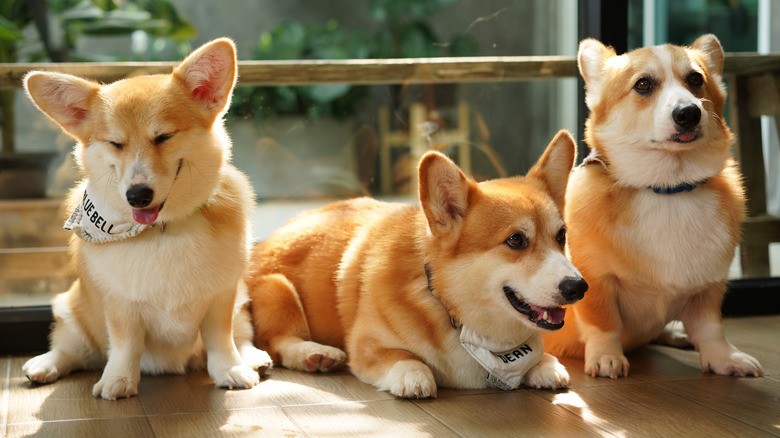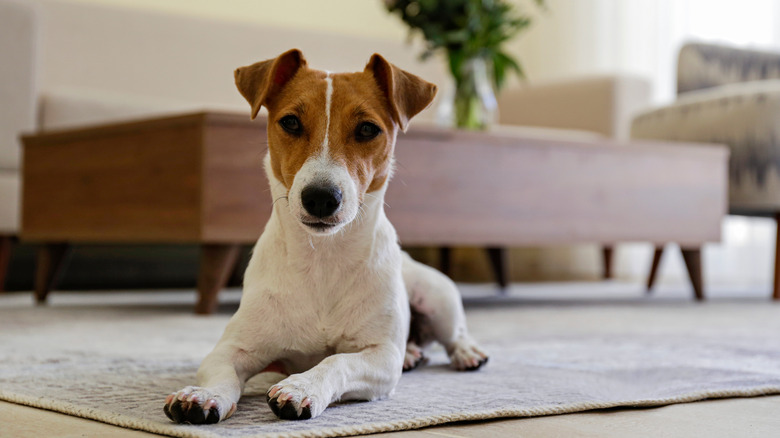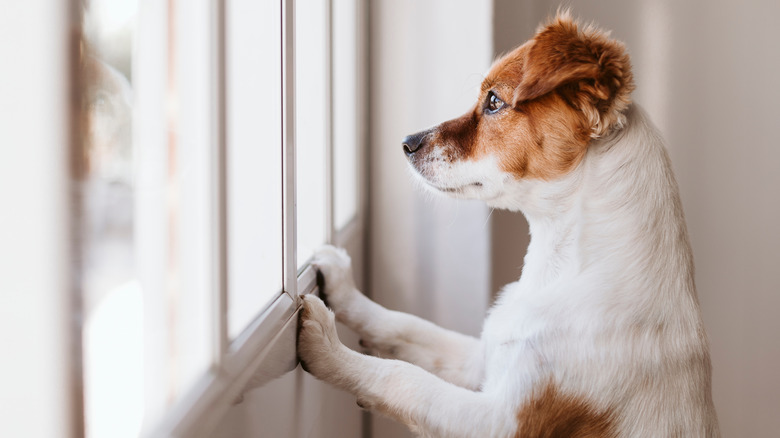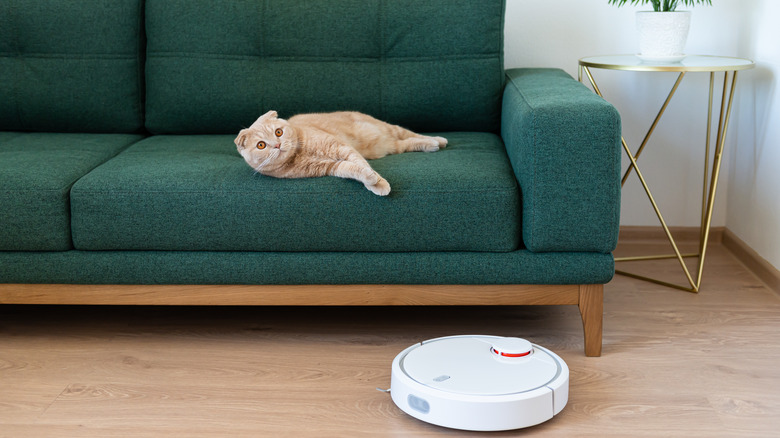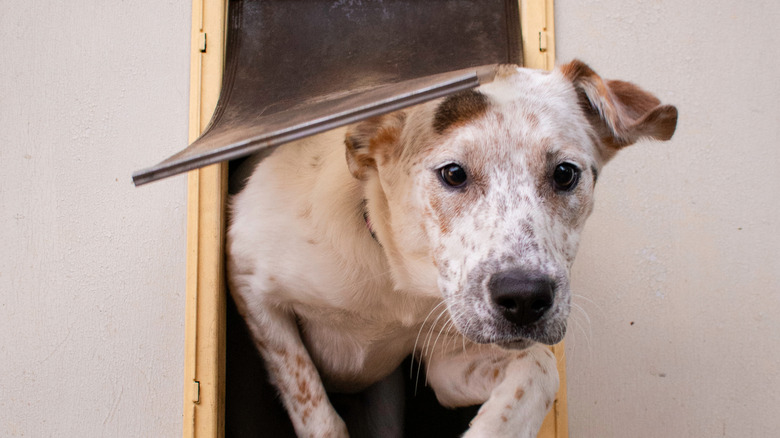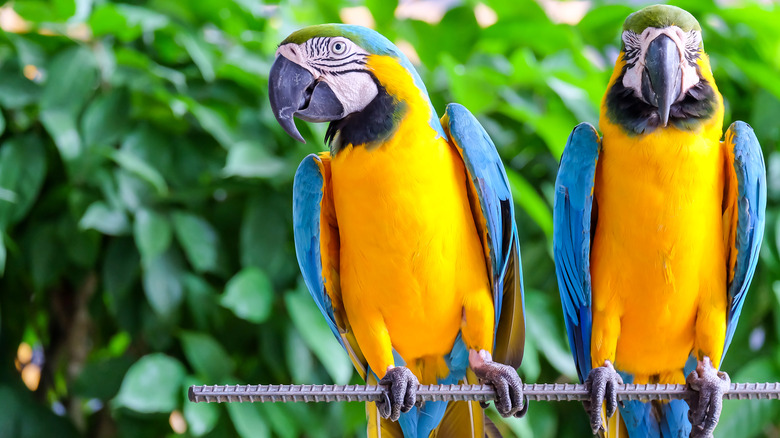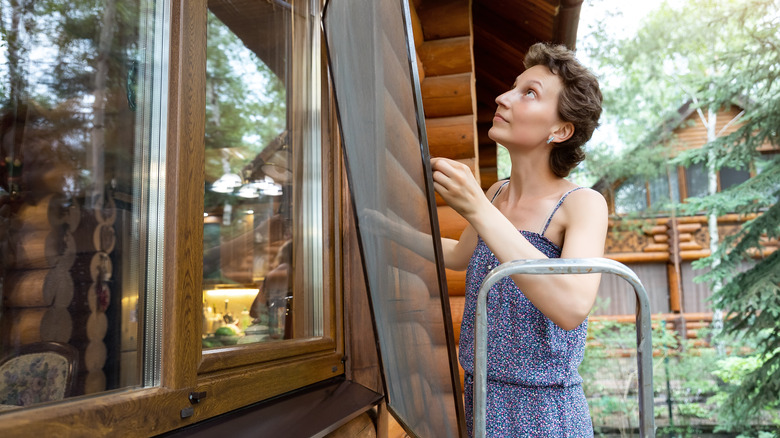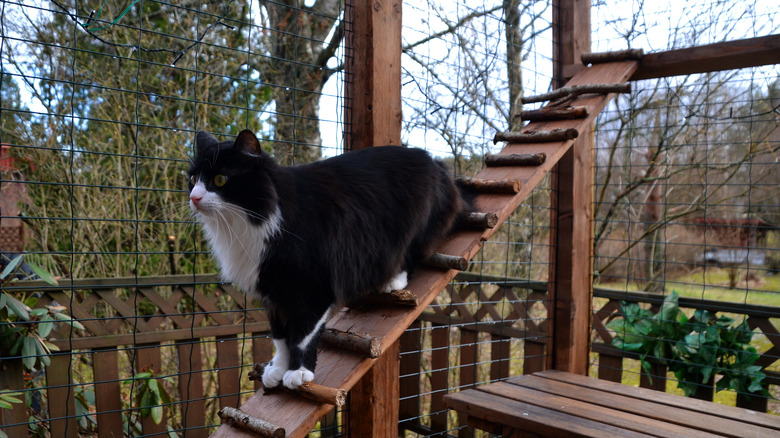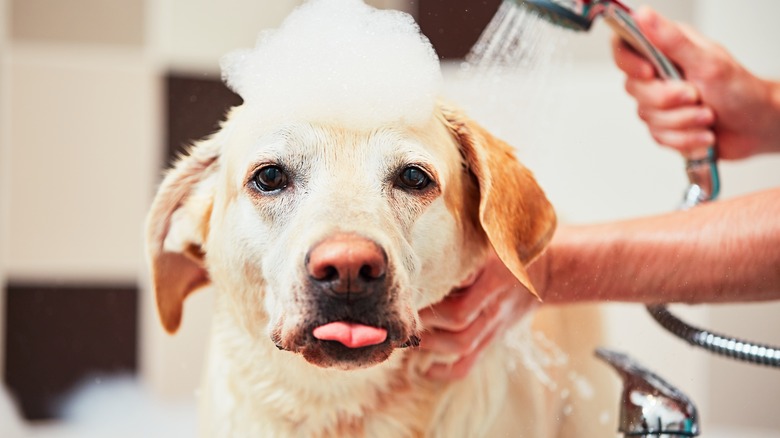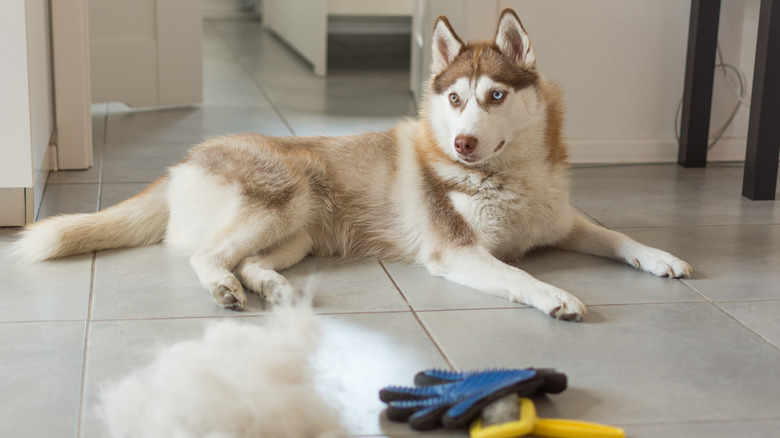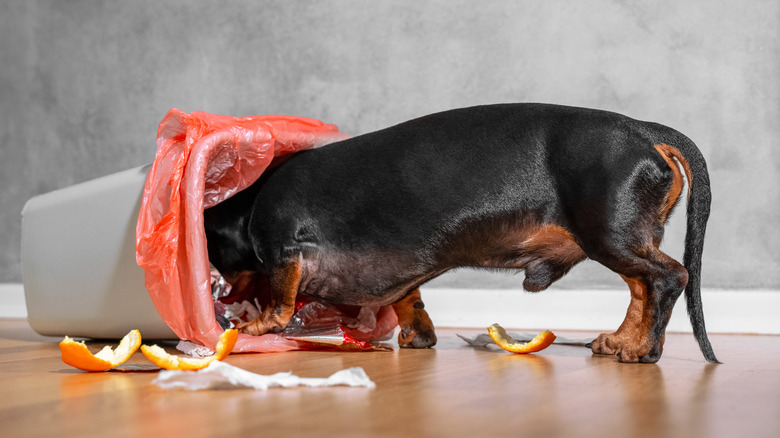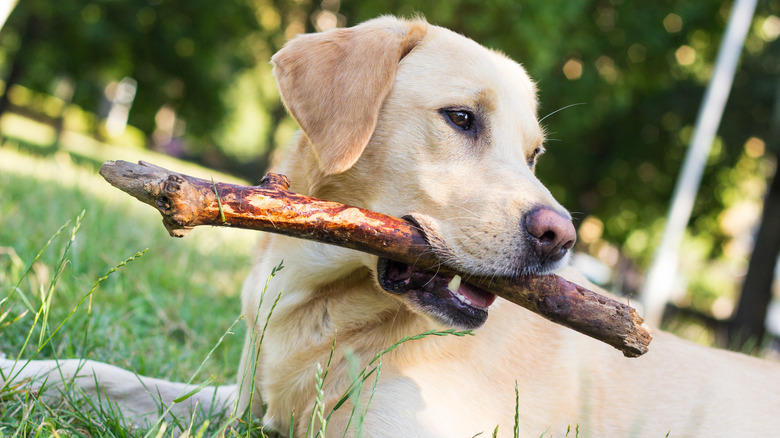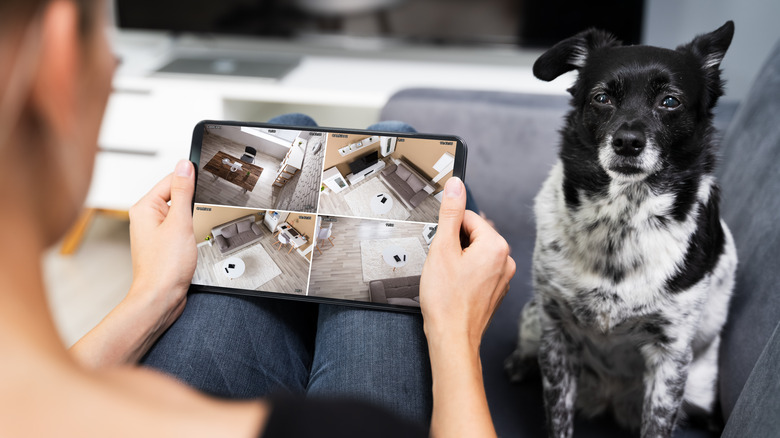How To Make Your Living Space More Pet-Friendly
Pets are officially part of the family. According to a survey by Psychology Today, more than 77% of dog and cat owners consider their pet an actual family member and would treat it as such. So, what exactly does that mean in practice? It could mean splashing out on pricey pet insurance to cover any unexpected medical bills (via Investopedia), throwing a lavish birthday party for your pet, or even writing your pet into your will. And while your pampered pet might be enjoying the high life, there are some perks for mom and dad, too.
The same Psychology Today survey reports that owning a pet and treating it as an important part of the family actually makes the rest of the family happier and healthier. Having a pet can help lower blood pressure, ease chronic pain, and reduce symptoms of anxiety and depression (via Homestead at Hamilton). These benefits and more are encouraging homeowners to invest more often in the happiness of their pets. So, many are starting to design spaces within their home with their pets' well-being in mind. Here's how you can make your home more pet-friendly.
Consider area rugs instead of carpet
Pets are messy; there's no way around it. They'll have accidents at 3 a.m., knock over your glass of red wine and spill it everywhere, and track muddy pawprints across the house, probably right after you've cleaned. It can be frustrating to deal with these disasters. But, one way to help mitigate these problems before they even happen is to remove your wall-to-wall carpet and invest in tile or wooden flooring instead, per HGTV. This way, when something happens, it's just a matter of quickly wiping the floor down. You will no longer have to lug out the carpet cleaner to mitigate tough stains.
If you still would like something warm on the ground for comfort and sound absorption, consider an area rug instead. It's easier to clean muddy paw prints and bathroom accidents off a washable rug than a carpet (via Architectural Digest).
Invest in stain-resistant fabrics
Unfortunately, carpet isn't the only thing your pet is likely to soil. No matter what kind of pet you have, it's likely something will happen to your bed, your chairs, and especially your couches. This can be everything from a bathroom accident to a puddle of drool while they enjoy a good nap. Because of its intricate construction, cleaning furniture can be even more difficult than cleaning carpet. Even more so, fabrics like velvet and silk cling to pet hair, making them nearly impossible to keep clean with a furry friend around.
So if you have a pet, purchasing items with easy-to-clean materials like leather, pleather, and Ultrasuede can save you from expensive messes well in advance (via HGTV). While these choices might suffer a few claw marks from your pet, they can easily be filled in. Additionally, the custom-made fabric Crypton is said to be stain-resistant, smell-resistant, and almost impossible to ruin.
Install large windows for easy neighborhood patrolling
Pets, especially dogs and cats, seem to enjoy watching the neighborhood from the front window. They do this for the same reason people do: They are nosy. Pets, like their owners, enjoy watching the world go by from the comfort of their homes. Whether it's squirrels or the mail carrier, they want to know who is coming and going. Gazing out the window can also be a form of enrichment for pets who spend most of their days inside, per Wag!
To safely encourage your pet's curiosity, one thing you can do is install a large window that is easily accessible to them. Whether it's low enough for your Corgi to peer out of, or just behind the couch so your cat has a comfortable perch, eChoice encourages pet owners to think about their pets' daily routines and what they enjoy doing. Then, create pet-friendly spaces within your home to accommodate those needs. One caveat about having large windows in the front of your home is that it isn't ideal if you have birds. They can potentially fly into the windowpanes, hurting themselves.
Keep them happy by keeping your home clean
Cats are typically very clean animals. They are particular about where they are willing to use the restroom, and also particular about the state of their litter box. They are also constantly grooming themselves. While dogs might be less so, you can still prevent maladies like ticks and fleas from bothering your pet by keeping a clean home. Any pets that shed or produce dander require more steps to keep the house clean. The American Kennel Club recommends that pet owners invest in daily vacuuming and dusting to keep their pets comfortable.
To cut down on the workload, pet owners might consider an automatic vacuum or an air filtration system to reduce dust and dander around the home. Finally, pet owners will find that utilizing a mudroom is one of the easiest things to do to keep a pet-friendly home. They function as a great buffer between the mess of the outside world and the solace of your home, although they can often get very messy. But the great thing is, the mess your pet creates will only be confined to one room.
Give pets a special entrance to your home
An easy way to make your living space more pet-friendly is to give them a special entrance to your home. According to Freedom Pet Pass, installing a doggie door can have a number of benefits for your pet. The door can increase your animal's independence and mental stimulation by allowing them to play outside as they please. It can also cut down on potty training disasters because your pet won't need to wait until you get home to relieve themselves.
Doggie doors have also gone high-tech. DogTipper notes that there are models that will only open once they scan your pet's specific microchip, ensuring that wildlife or other intruders don't make their way into your home. Even if you opt for a more classic doggie door, there are still a number of things you can do to keep your home secure. You can easily install a small camera on your back porch, place a motion sensor that triggers an alert, or even post a classic "beware of dog" sign (via Reader's Digest).
Purchase furniture just for them
Dogs, cats, and even birds do better when they have a safe and designated place within the home. While many pet owners prefer that their pets do not spend time on the furniture, many do. Even if your pet sleeps in bed with you every night, it's still a good idea for them to have their own bed to retreat to, just in case, per Homify.
Pets, just like humans, can sometimes become overwhelmed or overstimulated. They can also crave privacy and alone time. By creating a spot in your home just for them, filled with their designated furniture, you can make a safe and nurturing place for your pet. Sometimes it's a whole room, but even if it's just a small area that is tucked out of the way, your pet will appreciate it (via Porch). This is especially important for pets who like to climb, like cats. Having a scratching post and jungle gym for them will keep your cat mentally stimulated and fulfilled.
Install window screens to keep pets safe
Installing screens not only ensures your home has a nice breeze but also that your pet stays safe. Pet screens are particularly popular in more urban spaces where owners don't necessarily have access to an outdoor area for their animals. While some windows might come with screens already installed to keep out bugs, most of these screens are too flimsy to hold back a curious animal. Unfortunately, they can easily be chewed or scratched through, leaving your animal vulnerable to escaping, or falling and becoming injured, per SFGate. For maximum safety, you should use a thicker mesh for the screen.
However, something to keep in mind is that while some brands might market themselves as "pet safe," it might just mean that the mesh used won't harm your pet and will keep the window screen safe from damage, like scratching. But these brands won't necessarily keep a curious cat safely inside and will need to be reinforced (via Floppycats).
Consider an outdoor play area for your indoor pet
All pets deserve some time to play outdoors, but smaller pets can be in danger if left to their own devices in the yard. According to Pet MD, larger birds can swipe dogs, cats, or even rabbits out of their yards. One option to keep pets safe outside while playing is installing an aviary in your backyard. Aviaries are typically used for birds. Contracting site iCastle reports that songbirds tend to "sing like crazy" when allowed outside time, but they can also be used for other pets. Most famously, cats enjoy using outdoor aviaries, affectionately called "catios."
It's easy to build a catio for your feline friends with sturdy timber and some chicken wire. Some models are connected to the home via a smaller doggie door or open window, so the cat can come and go as they please. Others, however, are completely self-enclosed, giving Fluffy's outdoor playtime a bit more structure. The main benefit of a catio for your pet is increased mental stimulation, which is perfect for every bored house cat (via DIY Cuteness).
Construct an at-home dog washing station
Pets can experience anxiety at the groomers for all sorts of reasons. Some pets don't like traveling in the car, others (particularly rescue pets) don't like being left alone in strange locations, while others don't like to be handled by someone who isn't a part of their family, per Wag'n Tails. From the pet parent's point of view, taking your furry friend to the groomers often leads to you needing a car wash, too, as there is so much hair left behind. So, you might consider washing your pet at home instead, but it's often too cold outside to use the hose in the driveway. Not only that, but spending hours bent over your bathtub scrubbing your pooch is bad for your back. One way to avoid this and make your home more pet-friendly is to install an at-home dog wash.
DIY dog wash stations are becoming more popular among pet owners for their convenience. If you have experience with plumbing, you will be able to complete the project independently. However, if not, you'll want to hire a plumber to set things up initially (via Better Homes & Gardens). The project might seem expensive upfront, but it will save you so much time and energy that it will soon pay for itself tenfold.
Avoid textured walls to keep things clean
Having a pet means you'll have to clean up after them, but the decor you choose in your home can have a huge influence on just how difficult cleaning up after your pet will be in the end. For example, pet fur has a way of sticking to textured wallpaper, making it impossible to clean, per House Beautiful. And, if you have beautiful built-ins with intricate woodwork, you can be sure that you'll be digging pet hair out of them for years to come. Even if your pet isn't anywhere near the walls, they will still act as a hair magnet.
To avoid finding yourself in this situation, you should choose wall paint with a high gloss finish since the way it reflects light makes the space look cleaner. Plus, the finish tends to repel pet dander and hair, making it easier to clean (via Real Simple). A caveat: High gloss paint isn't very forgiving to mistakes, so any drips or uneven coverage will be very visible.
Pet-proof your kitchen
Dogs, cats, and even birds have been known to help themselves to trash cans without lids and unlocked cabinets, so pet-proofing your kitchen is very important when creating a pet-friendly home. To keep animals out of the trash, you can start by purchasing a trash can with a lid. However, this might only deter timid pets. Once your dog or cat finds out they can have a feast if they knock the trash can over, the lid might not be enough. Take your pet's personality into consideration to determine whether you need to take things a step further and place your trash can behind a closed door in a pantry or a cabinet under the sink, suggests Moving.com.
If you have a larger dog or a pet that can access higher areas like a bird or cat, consider the types of things you leave out on the counter. First, consider whether any of these items could be toxic if ingested by your animal. Next, consider if you want to share that food with your pet. For example, a few of our writers have cats that love to eat bread, so the bread at home must always be locked away.
Choose landscaping with your pets in mind
When you add pets to your family, you might consider pet-proofing the interior of your home. However, if you plan to spend any time outdoors with your pets, it's important to make sure your yard is a safe place for them, too. Start with taking a look at your fence. Is it tall enough that your pet can't jump over it? Are there any gaps in the fence that your pet could squeeze through? Would it be easy for your pet to dig under your fence? Taking care of these problems before bringing your pet home can save you the heartache of a lost or injured animal, per This Old House.
In addition to having pet-proof fencing, many common plants are toxic if ingested and should be cleared from the yard. For example, lilies are a common plant in many flowerbeds but can cause cats to have kidney failure. In addition, popular plants like amaryllis, poinsettia, mums, and aloe vera can cause harm to your pet. To prevent any accidents, become familiar with the ASPCA's guide to toxic and non-toxic plants.
Consider a pet camera for safety and peace of mind
Installing a pet camera at home is one of the easiest ways to make your living space more pet-friendly. Rolling Stone reports that there are plenty of models with night vision, as well as 360-degree views, so you don't have to worry about blind spots. This way, you can check on your pet at all hours to ensure they are okay even when you're not at home. In addition to monitoring your pet for safety (and the ability to get help quickly in an emergency), having a pet camera can also function more playfully. Many owners report that simply seeing their pet in its natural habitat is fascinating, as it's a great glimpse into the secret life of pets.
Some cameras even function as treat dispensers. So when your pet is looking particularly cute while you're away (or you're just feeling particularly guilty that day), you can send them a treat via a few clicks on your phone (via Hill's Pet Nutrition).
